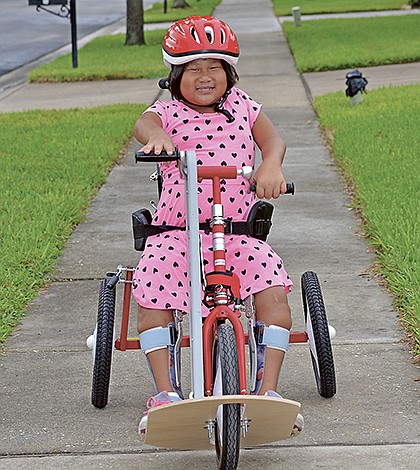- April 19, 2024
-
-
Loading

Loading

WINTER GARDEN — With her parents’ help, 9-year-old Claire Singletary fastens the helmet strap under her chin and the bicycle seatbelt around her body — and then she’s off for a few moments of independence. The grin broadens on the face of this determined little Winter Garden resident as she learns to maneuver the hand pedals on a bike made specifically for her. It didn’t take long for her to master the three-point turn.
“It’s special because I can ride it, and I can go fast,” Claire said.
The bike came from Ambucs, a non-profit service organization that creates mobility and independence for people with disabilities. There is no cost to the families.
The AmTryke hand tricycle has a foot platform, is adjustable and can be shifted as Claire’s arms and legs grow.
Claire was born in China and diagnosed with arthrogryposis, a condition characterized by constricted joints and surrounding muscles that are weak, stiff or missing. She was 2 1/2 and living in foster care when Richard and Angela Singletary, of Winter Garden, traveled to Asia in 2008 to meet her. The couple had adopted Hannah, also from China, in 2004, and wanted her to have someone she could connect with culturally. The Singletarys also have two biological sons, Tyler and Jacob.
“We saw her smile and said, ‘That’s our little girl,’” Richard Singletary said of when they visited Claire in the foster home.
When they first laid eyes on her, the toddler was sitting awkwardly with club feet attached to legs that were folded inward. Doctors said she would never walk.
The parents have learned not to put restrictions on their daughter — she tends to defy them all. After 12 surgeries, not only is Claire walking with the aid of leg braces, but also, she even manages to run and climb the stairs of their two-story home. She swims, can kick a soccer ball and has played on a special-needs baseball team in Clermont.
“She’s amazing and learning how to do things to adapt,” Richard Singletary said. “She figures things out.”
She has endured operations to cut tendons behind her knees to straighten her legs and surgeries to cut her femurs and twist them into shape. She has spent about a year in various body casts. She has plates and screws and pins in her knees.
Claire also has a sunny disposition, smiling as she makes her way around the house or out to the garage or the swimming pool. She’s excited to start fourth grade at Whispering Oak Elementary School.
Amber Yampolsky, Claire’s physical therapist at Orlando Health, has been instrumental in her growth in terms of physical activity. She also recommended the family for the special bicycle, which arrived last week.
The Singletarys originally were told that Claire didn’t have any quadriceps, but her father said there is definitely something there. Watching her in action is proof.
She will always need the support of braces because of her weak muscles, Angela Singletary said.
Her husband was quick to add: “She’s already come so much further than we ever expected.”
—
Children with arthrogryposis are born with joint contractures. Some of their joints don’t move as much as normal and can even be stuck in one position. Often, the muscles around these joints are thin, weak, stiff or missing. Extra tissue might have formed around the joints, holding them in place.
Most contractures happen in the arms and the legs, but they can also be located in the jaw and the spine.
The main cause of arthrogryposis is fetal akinesia. This means the baby does not move much inside the womb. Moving helps a baby’s joints, muscles and tendons develop. If a baby doesn’t move much, these parts might not develop well and extra tissue can form in the joints, making movement harder.
—
Contact Amy Quesinberry Rhode at [email protected].